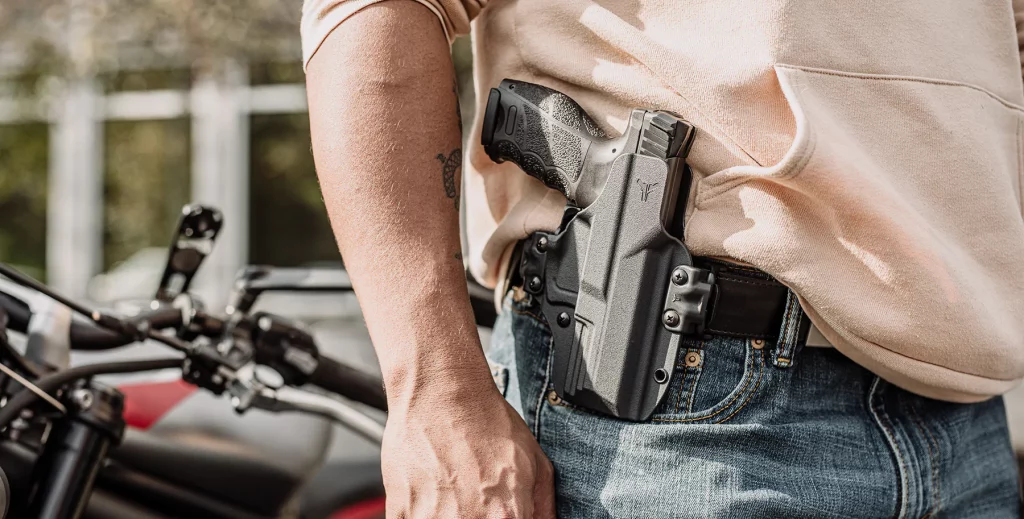Pulling a gun from your holster might seem fancy enough in theory, but you’d be surprised at how tricky it can be in emergencies. This article will discuss why your holster draw as a law enforcement officer or a secret service agent sucks a bit.

Habits
Some bad habits licensed gun carriers, especially policemen, engage in when they are about to draw their gun from their holster; Fishing and Bowling. Fishing is when you draw from your holster with the muzzle of your gin pointing upward before it pushes out to your target. Bowling is the same, except this time, the gun is pointing downwards. Not only are these two holster draw methods flawed, but they are also likely more dangerous in threatening situations.
These two habits lead to wasted movement, and if there’s one thing a law enforcement officer doesn’t have when pulling his gun out in emergencies, it’s time. Also, these actions will significantly hinder your holster draw and prevent it from being smooth. The best way to pull a gun, known as the ‘push out’ method, will be explained later.
Clothing
The thing is, while you were at the range practicing your shooting and holster draw, it was smooth sailing. It doesn’t mean it would be as smooth out there when it comes down to it. If you’re undercover and you have to wear regular clothing, then the training wouldn’t matter.
If you are the kind who lives in sunny areas and cannot afford to be in full gear all the time, this applies to you a lot. Except you know how to work around it, your shirt’s style and material significantly impact your holster draw. Tight shirts, for example, are most likely to slow down a holster draw, if not completely ruin it.
This is because getting your shirt out of the way so you can draw takes time – too much time. If the standard time for a holster draw is 1.5 seconds, you will waste precious time if you spend half that time fumbling with your shirt. Half of 1.5 seconds might seem like nothing at all, but it makes all the difference in the world in emergency cases. We recommend that you wear long and flowy shirts – especially for those who live in hot areas. The shirts may flow around in the wind, but they are great for concealment and a smooth holster draw.
Placement
When you place your gun in the holster, you have to make sure you put it in a particular position to make it easy to reach and grab. If you have to raise your shirt’s bottom before you can successfully draw, you need to work on your gun placement. You have to take note and make sure your gun is not far back, so you don’t encounter real problems out in the field. This goes back to timing.
The time you have to draw your gun and keep it leveled with the target is short already, don’t complicate things by wasting more time trying to reach the weapon because it is in the far back. Wrong placement of your firearm can hurt your holster draw. If it’s placed wrongly by even AN INCH, it is dangerous. We can’t stress enough that the placement of your gun has to be perfect. An inch to the wrong side might give you problems.
Positioning
We recommend you try the appendix positioning. It has been proven more than once that this positioning will significantly enhance your holster draw and even save time. You also don’t have to worry about clothing if your gun is in this position. This position has nothing to do with your clothing style in any way. Tight shirts will pose no problem to your holster draw. This is because the gun is closer to the support side hand, making it easy to reach. Raising the shirt is also easy, so you basically won’t waste time fumbling with your shirts or the gun while trying to draw.
Grip Sleeves
You may not know this, but grip sleeves go a long way in enabling a smooth holster draw, especially if your gun’s frame isn’t the one you want. Coupled with one or two of the problems listed above, the absence of a grip sleeve on your gun sometimes, too, might cause a problem in the field.
We know tastes differ, and we know you can’t have it all. Imagine having a sweet gun that you like, but its frame is middle-sized, and you prefer a large frame. Now the wise thing would be to get the same weapon in another size, but in the meantime, you can use rubber grip sleeves to enhance your grip on the firearm. You never know when a balanced grip on your pistol will help you, especially if you want to draw.
Practice
We cannot stress this enough—practice! Keep in mind that you are not practicing to remember; you are practicing to build your muscle memory because no matter how hard you practice, your draws would not be perfect all the time. The point here is not just to have a smooth holster draw. It’s to be able to save a life when in threatening conditions. Just make sure you practice. Who knows, you might discover a neat life hack or two in the process.
Now, the push-out method of drawing is when you immediately direct the gun’s muzzle towards the target after drawing it from your holster. Build up good habits if you want to be a better shooter.
Finally, always remember to breathe during emergencies. You’d be surprised at how often people forget to breathe when they are highly stressed. Try as well to relax, even though everything in your surroundings is telling you the complete opposite. One thing you should always do is to take note of your surroundings. Don’t always focus on the threat you can see; there might be more significant threats that you can’t.
